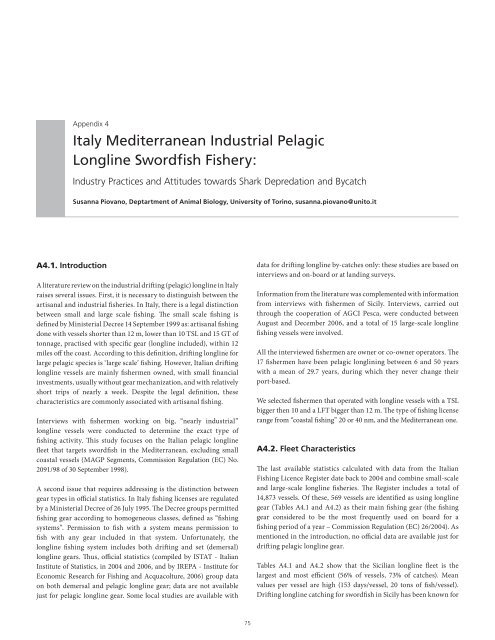Shark Depredation and Unwanted Bycatch in Pelagic Longline
Shark Depredation and Unwanted Bycatch in Pelagic Longline
Shark Depredation and Unwanted Bycatch in Pelagic Longline
You also want an ePaper? Increase the reach of your titles
YUMPU automatically turns print PDFs into web optimized ePapers that Google loves.
Appendix 4<br />
Italy Mediterranean Industrial <strong>Pelagic</strong><br />
Longl<strong>in</strong>e Swordfish Fishery:<br />
Industry Practices <strong>and</strong> Attitudes towards <strong>Shark</strong> <strong>Depredation</strong> <strong>and</strong> <strong>Bycatch</strong><br />
Susanna Piovano, Deptartment of Animal Biology, University of Tor<strong>in</strong>o, susanna.piovano@unito.it<br />
A4.1. Introduction<br />
A literature review on the <strong>in</strong>dustrial drift<strong>in</strong>g (pelagic) longl<strong>in</strong>e <strong>in</strong> Italy<br />
raises several issues. First, it is necessary to dist<strong>in</strong>guish between the<br />
artisanal <strong>and</strong> <strong>in</strong>dustrial fisheries. In Italy, there is a legal dist<strong>in</strong>ction<br />
between small <strong>and</strong> large scale fish<strong>in</strong>g. The small scale fish<strong>in</strong>g is<br />
def<strong>in</strong>ed by M<strong>in</strong>isterial Decree 14 September 1999 as: artisanal fish<strong>in</strong>g<br />
done with vessels shorter than 12 m, lower than 10 TSL <strong>and</strong> 15 GT of<br />
tonnage, practised with specific gear (longl<strong>in</strong>e <strong>in</strong>cluded), with<strong>in</strong> 12<br />
miles off the coast. Accord<strong>in</strong>g to this def<strong>in</strong>ition, drift<strong>in</strong>g longl<strong>in</strong>e for<br />
large pelagic species is ‘large scale’ fish<strong>in</strong>g. However, Italian drift<strong>in</strong>g<br />
longl<strong>in</strong>e vessels are ma<strong>in</strong>ly fishermen owned, with small f<strong>in</strong>ancial<br />
<strong>in</strong>vestments, usually without gear mechanization, <strong>and</strong> with relatively<br />
short trips of nearly a week. Despite the legal def<strong>in</strong>ition, these<br />
characteristics are commonly associated with artisanal fish<strong>in</strong>g.<br />
Interviews with fishermen work<strong>in</strong>g on big, “nearly <strong>in</strong>dustrial”<br />
longl<strong>in</strong>e vessels were conducted to determ<strong>in</strong>e the exact type of<br />
fish<strong>in</strong>g activity. This study focuses on the Italian pelagic longl<strong>in</strong>e<br />
fleet that targets swordfish <strong>in</strong> the Mediterranean, exclud<strong>in</strong>g small<br />
coastal vessels (MAGP Segments, Commission Regulation (EC) No.<br />
2091/98 of 30 September 1998).<br />
A second issue that requires address<strong>in</strong>g is the dist<strong>in</strong>ction between<br />
gear types <strong>in</strong> official statistics. In Italy fish<strong>in</strong>g licenses are regulated<br />
by a M<strong>in</strong>isterial Decree of 26 July 1995. The Decree groups permitted<br />
fish<strong>in</strong>g gear accord<strong>in</strong>g to homogeneous classes, def<strong>in</strong>ed as “fish<strong>in</strong>g<br />
systems”. Permission to fish with a system means permission to<br />
fish with any gear <strong>in</strong>cluded <strong>in</strong> that system. Unfortunately, the<br />
longl<strong>in</strong>e fish<strong>in</strong>g system <strong>in</strong>cludes both drift<strong>in</strong>g <strong>and</strong> set (demersal)<br />
longl<strong>in</strong>e gears. Thus, official statistics (compiled by ISTAT - Italian<br />
Institute of Statistics, <strong>in</strong> 2004 <strong>and</strong> 2006, <strong>and</strong> by IREPA - Institute for<br />
Economic Research for Fish<strong>in</strong>g <strong>and</strong> Acquacolture, 2006) group data<br />
on both demersal <strong>and</strong> pelagic longl<strong>in</strong>e gear; data are not available<br />
just for pelagic longl<strong>in</strong>e gear. Some local studies are available with<br />
data for drift<strong>in</strong>g longl<strong>in</strong>e by-catches only: these studies are based on<br />
<strong>in</strong>terviews <strong>and</strong> on-board or at l<strong>and</strong><strong>in</strong>g surveys.<br />
Information from the literature was complemented with <strong>in</strong>formation<br />
from <strong>in</strong>terviews with fishermen of Sicily. Interviews, carried out<br />
through the cooperation of AGCI Pesca, were conducted between<br />
August <strong>and</strong> December 2006, <strong>and</strong> a total of 15 large-scale longl<strong>in</strong>e<br />
fish<strong>in</strong>g vessels were <strong>in</strong>volved.<br />
All the <strong>in</strong>terviewed fishermen are owner or co-owner operators. The<br />
17 fishermen have been pelagic longl<strong>in</strong><strong>in</strong>g between 6 <strong>and</strong> 50 years<br />
with a mean of 29.7 years, dur<strong>in</strong>g which they never change their<br />
port-based.<br />
We selected fishermen that operated with longl<strong>in</strong>e vessels with a TSL<br />
bigger then 10 <strong>and</strong> a LFT bigger than 12 m. The type of fish<strong>in</strong>g license<br />
range from “coastal fish<strong>in</strong>g” 20 or 40 nm, <strong>and</strong> the Mediterranean one.<br />
A4.2. Fleet Characteristics<br />
The last available statistics calculated with data from the Italian<br />
Fish<strong>in</strong>g Licence Register date back to 2004 <strong>and</strong> comb<strong>in</strong>e small-scale<br />
<strong>and</strong> large-scale longl<strong>in</strong>e fisheries. The Register <strong>in</strong>cludes a total of<br />
14,873 vessels. Of these, 569 vessels are identified as us<strong>in</strong>g longl<strong>in</strong>e<br />
gear (Tables A4.1 <strong>and</strong> A4.2) as their ma<strong>in</strong> fish<strong>in</strong>g gear (the fish<strong>in</strong>g<br />
gear considered to be the most frequently used on board for a<br />
fish<strong>in</strong>g period of a year – Commission Regulation (EC) 26/2004). As<br />
mentioned <strong>in</strong> the <strong>in</strong>troduction, no official data are available just for<br />
drift<strong>in</strong>g pelagic longl<strong>in</strong>e gear.<br />
Tables A4.1 <strong>and</strong> A4.2 show that the Sicilian longl<strong>in</strong>e fleet is the<br />
largest <strong>and</strong> most efficient (56% of vessels, 73% of catches). Mean<br />
values per vessel are high (153 days/vessel, 20 tons of fish/vessel).<br />
Drift<strong>in</strong>g longl<strong>in</strong>e catch<strong>in</strong>g for swordfish <strong>in</strong> Sicily has been known for<br />
75












